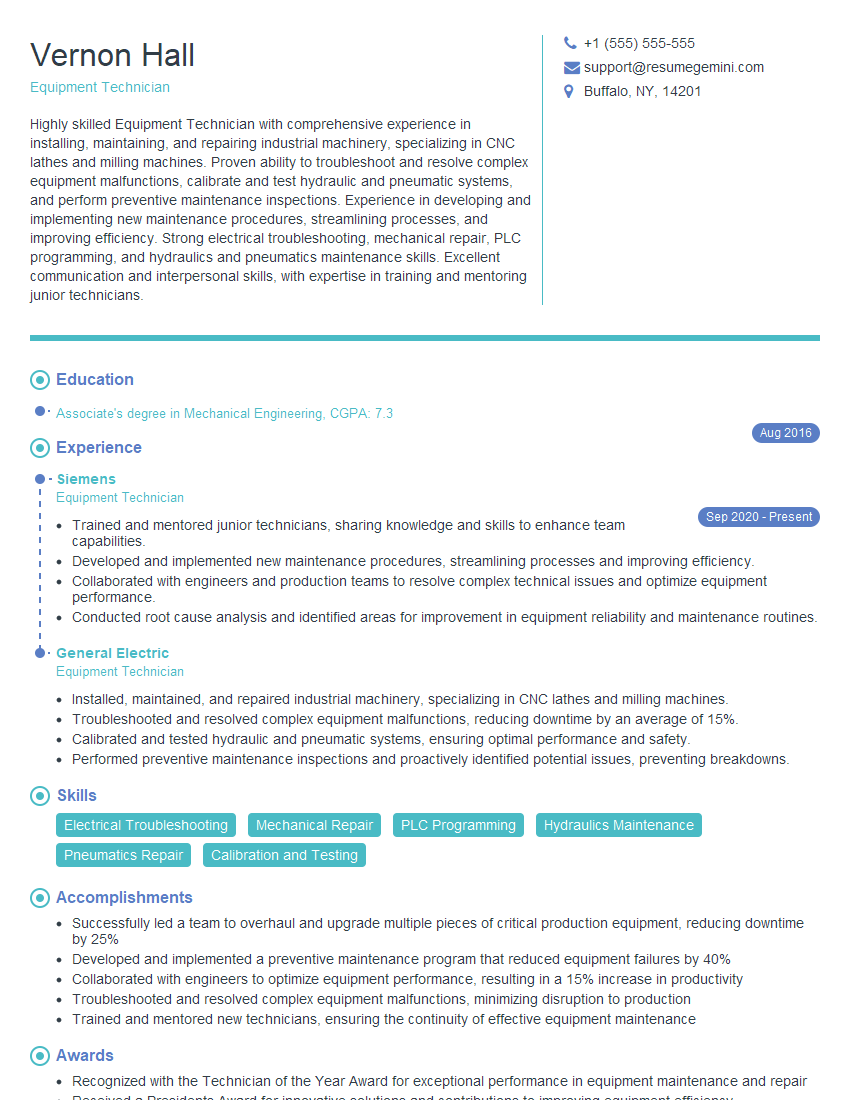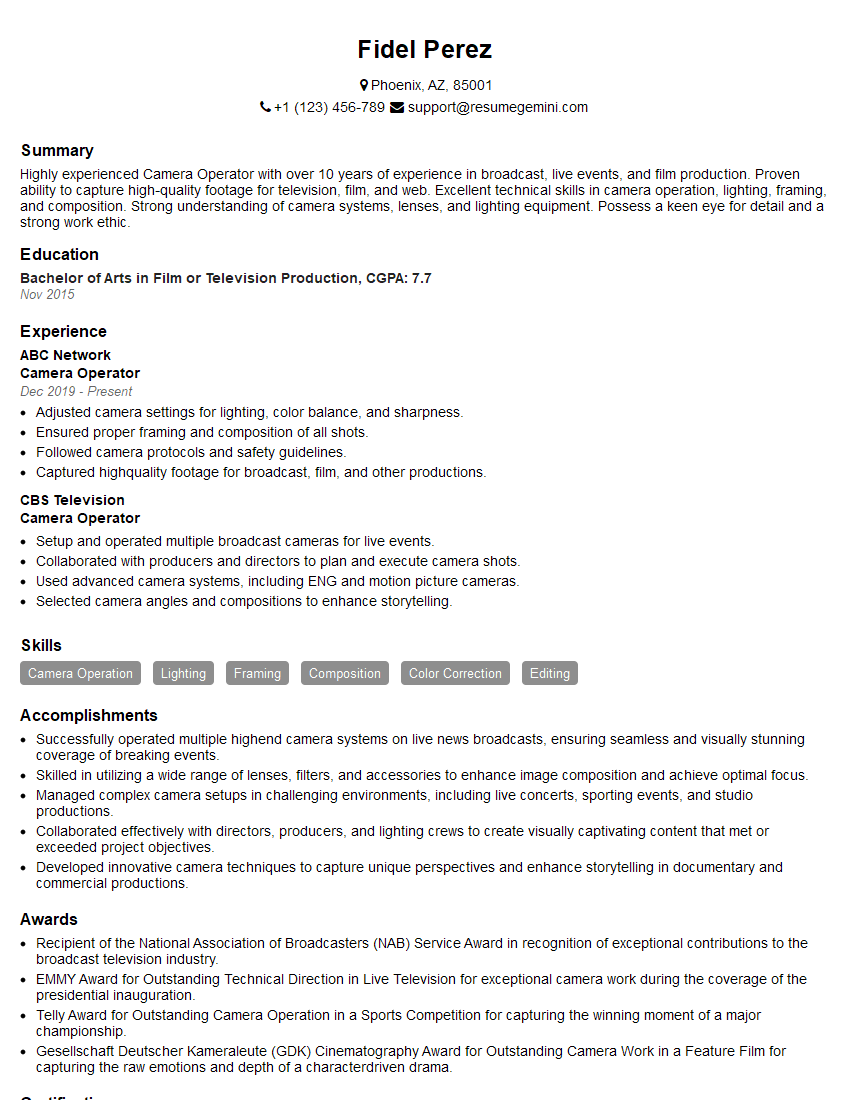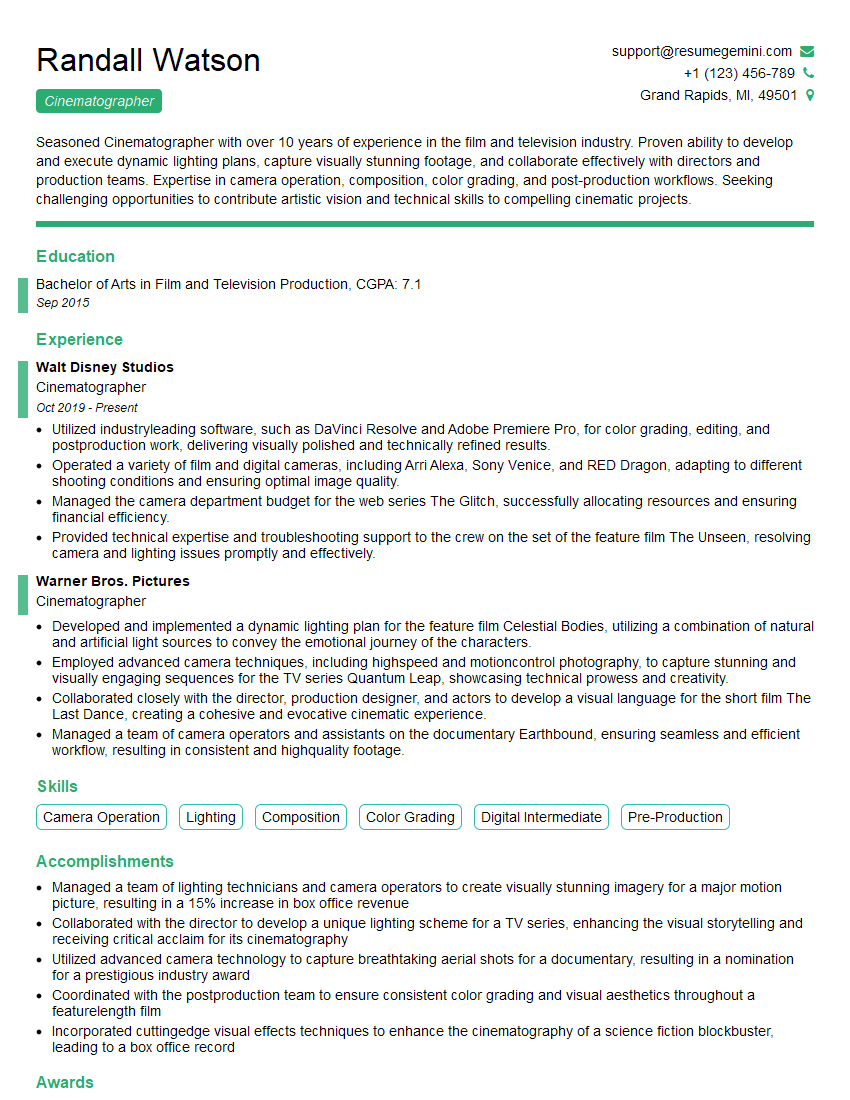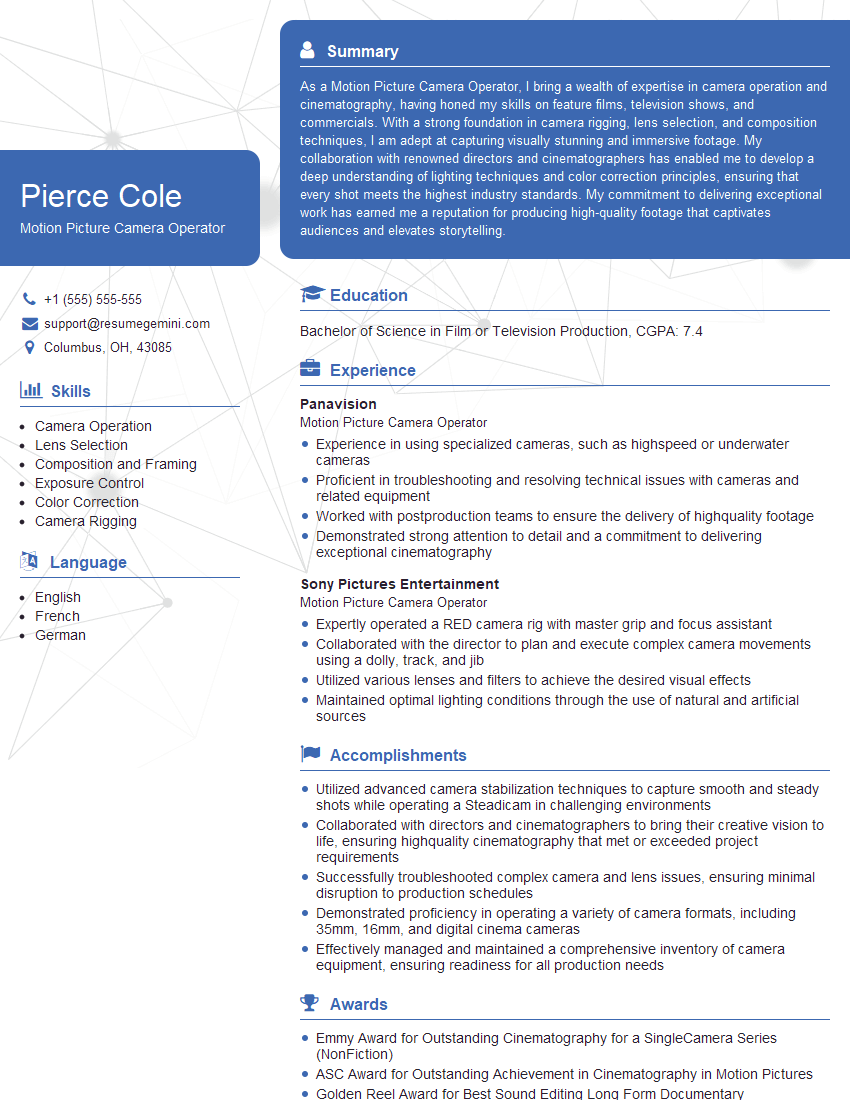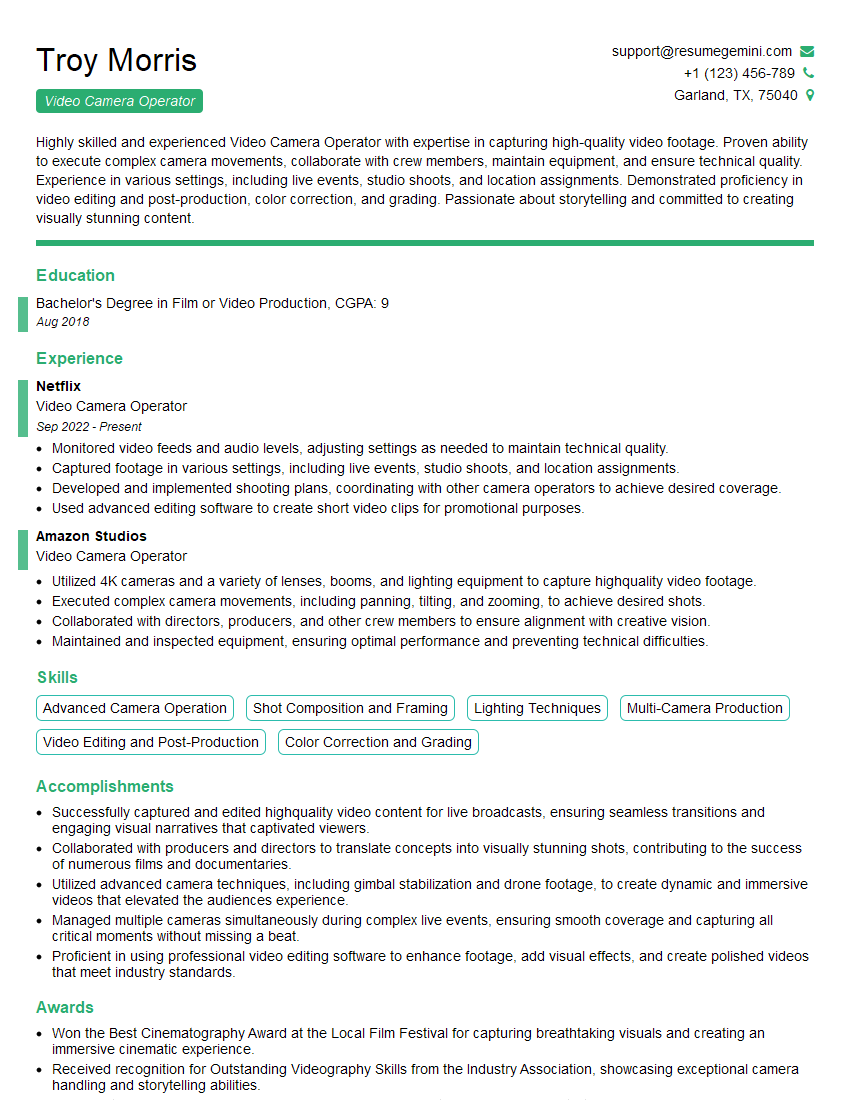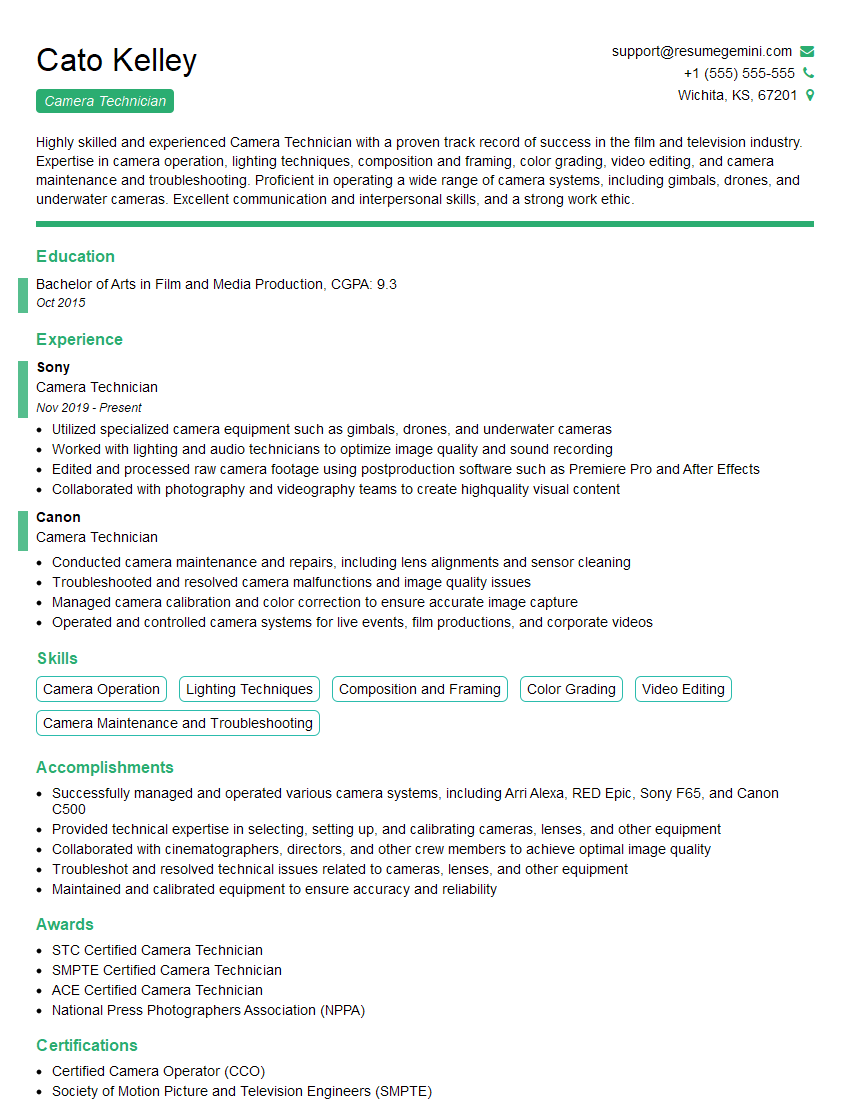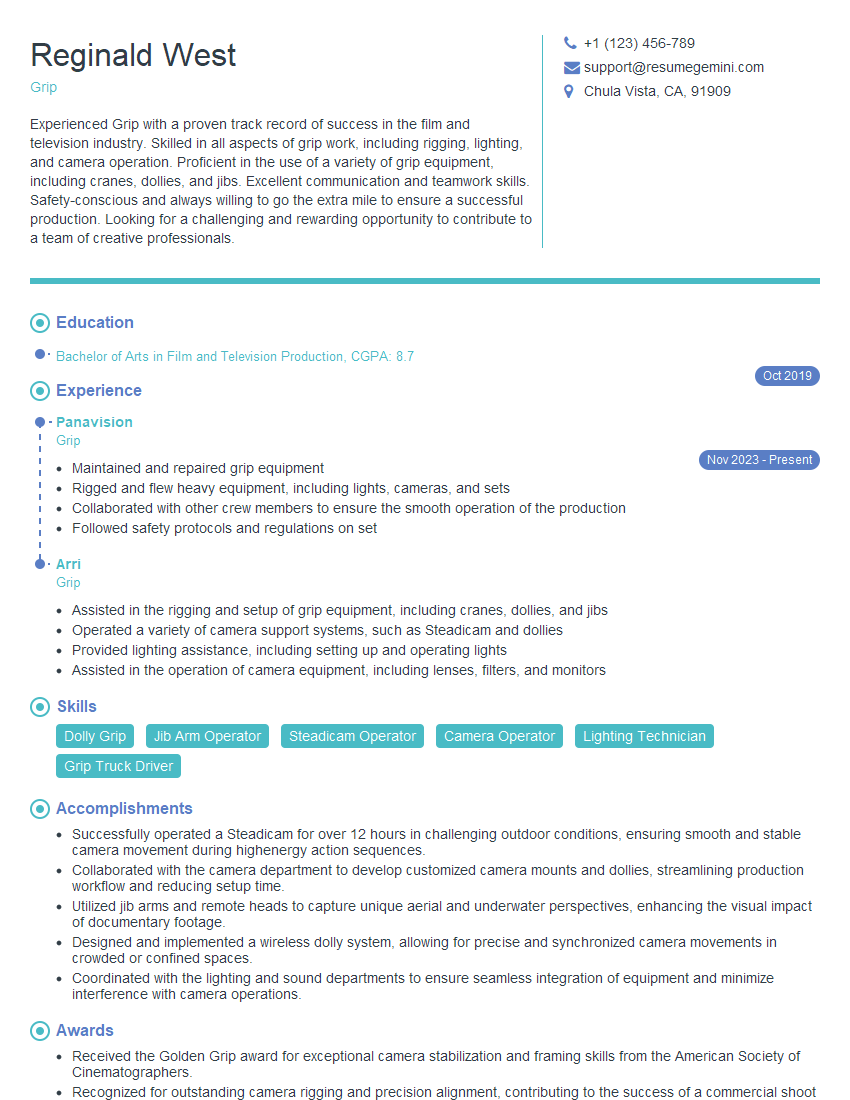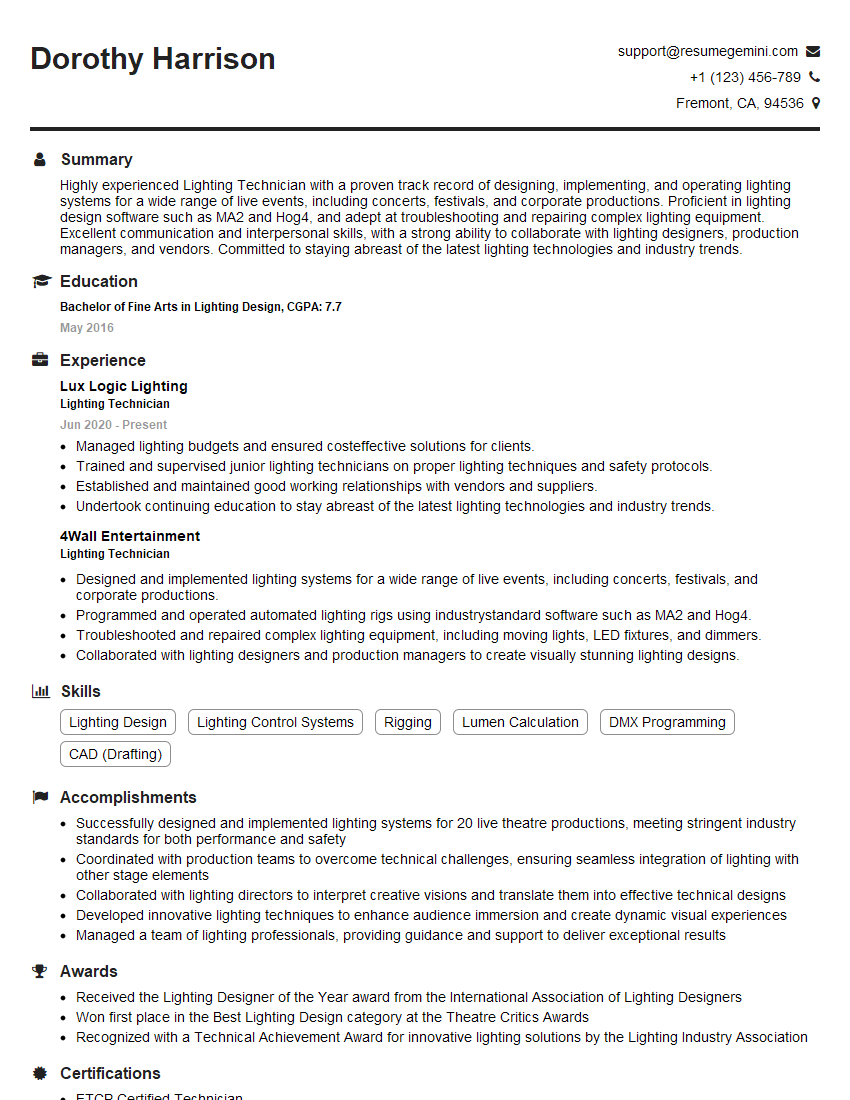Unlock your full potential by mastering the most common Camera Grip interview questions. This blog offers a deep dive into the critical topics, ensuring you’re not only prepared to answer but to excel. With these insights, you’ll approach your interview with clarity and confidence.
Questions Asked in Camera Grip Interview
Q 1. Explain the different types of camera supports you are familiar with.
Camera supports are crucial for achieving stable and controlled shots. They range from simple to highly complex systems, each designed for specific needs. I’m experienced with a wide variety of these, including:
- Tripods: The most basic, offering stability for static shots. Different tripods exist for various weight capacities and shooting styles, from lightweight travel tripods to heavy-duty studio tripods. I’ve used everything from Manfrotto 190XPROB to Gitzo Systematic series, depending on the project’s requirements.
- Monopods: Provide more mobility than tripods while offering some stability. Ideal for quick setups or situations where a tripod isn’t practical, like walking shots.
- Gimbal Stabilizers: These motorized devices counteract camera shake, producing incredibly smooth footage, even while walking or running. I have extensive experience with both handheld gimbals like DJI Ronin-S and larger, more sophisticated systems like Freefly MōVI.
- Slider Systems: These allow for controlled, smooth horizontal camera movements, creating a professional look. They come in various lengths and can be powered or manually operated.
- Jib Arms/Crane Systems: Used for dynamic shots, providing vertical and horizontal movement, often offering sweeping cinematic shots. These are complex systems requiring careful planning and execution. I’ve worked with several different jib arm manufacturers, ensuring I can adapt to any on-set situation.
- Steadicam Systems (see next answer for details): Highly advanced systems for smooth, fluid movement, often used for walking shots or dynamic scenes that require stability even when the operator is moving.
Q 2. Describe your experience with Steadicam operation.
My Steadicam experience spans several years and various models. I’ve operated both traditional Steadicam rigs and newer, lighter systems. Proficiency in Steadicam operation goes beyond simply holding the camera; it’s about understanding body mechanics, counter-balancing, and anticipating movement. The key is maintaining a fluid and natural look. I’ve found that proper posture and balance are essential. The initial setup is critical, ensuring the correct weight distribution and counterbalance arm configuration for the specific camera and lens combination. Once balanced, maintaining fluidity is crucial; this requires practice and an understanding of how your body movements directly influence the camera’s motion. I frequently practice arm exercises and always prioritize safety for both the gear and myself during Steadicam operation. A recent project involved a chase scene, requiring precise movements and the ability to react to the actors’ quick changes in direction. Successfully pulling that off needed extensive pre-planning and on-the-fly adjustments.
Q 3. How do you maintain camera balance and stability during challenging shots?
Maintaining camera balance and stability during challenging shots requires a multifaceted approach. It’s a combination of technical skills, creative problem-solving, and a deep understanding of the equipment. Here’s how I tackle it:
- Proper Rig Setup: Precise balancing is paramount. I carefully adjust counterweights and ensure the entire rig is well-balanced for the specific camera and lens combination.
- Body Mechanics: Fluid movements are key. I employ smooth, controlled movements, avoiding jerky actions that transfer to the camera. Years of practice have honed my body control.
- Environmental Awareness: I anticipate obstacles, like uneven terrain or sudden gusts of wind, adjusting my movements accordingly. For example, walking on uneven ground might require shorter steps and subtle shifts in weight distribution.
- Choosing the Right Support: I select the appropriate support system for the shot. A Steadicam is ideal for smooth, fluid movement, while a tripod is better for static shots.
- Post-Production Stabilization: As a last resort, I utilize post-production stabilization software (like Adobe After Effects) to refine shots and minimize minor shakes that may have slipped through. However, this is always a secondary measure; the goal is always to get the shot as clean as possible during filming.
Q 4. What are some common problems encountered during camera rigging, and how do you solve them?
Camera rigging presents several potential problems. Anticipating these and having solutions ready is essential. Some common issues include:
- Improper Weight Distribution: This leads to imbalance and instability. Solution: Meticulous balancing of the rig, possibly adjusting counterweights.
- Loose Connections: Failing to properly tighten clamps or connections can cause equipment failure during a shoot. Solution: Always double-check all connections and tighten them securely, employing appropriate tools.
- Cable Management: Tangled cables can impede movement and even damage equipment. Solution: Use cable ties, wraps, or other organization methods to keep cables neat and secure.
- Mechanical Failure: Sometimes, equipment malfunctions. Solution: Having backup equipment, including spare batteries and camera bodies, is crucial. Understanding basic troubleshooting and repair can save the day.
- Environmental Factors: Weather can severely affect a shoot. Solution: Appropriate weather protection for cameras and other equipment, coupled with contingency plans for unexpected conditions.
Q 5. Explain your experience with various camera rigs and their setup.
My experience with various camera rigs is extensive. I’ve worked with numerous setups, from simple shoulder rigs for documentary work to complex multi-camera rigs for large-scale productions. Setup varies greatly depending on the project, but generally involves these steps:
- Choosing the Right Rig: Selection depends on the camera, lens, and type of shot. For example, a shoulder rig for handheld shots, a tripod for static ones, or a Steadicam for smooth moving shots.
- Camera Mounting: Ensuring the camera is securely and correctly mounted is paramount. This often includes quick-release plates for easy setup and switching between supports.
- Balancing: Critical for stability and smooth operation. This involves adjusting counterweights to perfectly balance the camera and lens combination.
- Monitoring Equipment: Attaching monitors, follow-focus systems, and other accessories while ensuring proper power and connectivity. This enhances usability during filming.
- Testing and Adjustments: Testing the entire setup before a take is crucial to ensure everything functions as expected. I always make adjustments to optimize the setup for optimal performance.
For instance, I recently set up a three-camera rig for a live event, each with its own independent monitor and audio feed, which needed precise synchronization and positioning.
Q 6. Describe your understanding of camera movement and its impact on storytelling.
Camera movement is a powerful storytelling tool. It significantly impacts the audience’s emotional response and understanding of the scene. Different movements convey different feelings and meanings:
- Static Shots: Convey a sense of calm, observation, or importance. A static shot of a character’s face can emphasize their emotional state.
- Panning: Following a moving subject or revealing a wider environment. A slow pan across a landscape can highlight its beauty.
- Tilting: Revealing height or depth. Tilting up to a towering building can showcase its grandeur.
- Tracking/Dolly Shots: Following a subject, maintaining a consistent distance while maintaining emotional connection. A tracking shot following a character walking through a city reveals both their journey and the environment.
- Zooming: Changing the perspective and emphasizing specific details. Zooming in can draw attention to an important object or create suspense.
- Crane/Jib Shots: Providing sweeping views, often used to show vast landscapes or emphasize a character’s position within a large space. A high-angle crane shot can show a character’s vulnerability.
The choice of camera movement should always be driven by the narrative, helping build tension, convey emotion, and guide the audience’s eye effectively. I carefully consider the intended impact of each movement and tailor it accordingly.
Q 7. How do you ensure the safety of the camera and equipment during operation?
Safety is paramount. I prioritize the safety of the camera equipment and myself, and anyone else involved, during every operation. My safety protocols include:
- Proper Rigging Techniques: Using correct techniques to ensure the equipment is securely mounted and balanced prevents accidents from falls or equipment malfunctions.
- Environmental Awareness: Being mindful of the surroundings and anticipating potential hazards, like tripping hazards, traffic, or weather conditions.
- Equipment Maintenance: Regular inspection and maintenance of the equipment ensures it’s in good working order, minimizing the risk of malfunctions.
- Teamwork and Communication: Effective communication with the crew is essential for coordination and safety, especially during complex shots or in crowded environments.
- Backup Systems: Having backup equipment and contingency plans reduces the risk of a shooting disruption due to equipment failure.
- Safe Lifting Practices: When handling heavier equipment, I employ safe lifting techniques to prevent injury.
For example, on a recent outdoor shoot, I adjusted our plan to account for unexpectedly high winds, relocating equipment to a sheltered area and using additional sandbags to secure the tripod and preventing any damage to the equipment.
Q 8. How familiar are you with different types of lenses and their applications?
My familiarity with lenses extends beyond mere identification; I understand their optical properties and how they impact image quality and storytelling. I’m proficient with various lens types, including prime lenses (known for their sharp image quality and shallow depth of field, perfect for portraits or isolating subjects), zoom lenses (offering flexibility in framing without changing lenses, ideal for documentaries or fast-paced action), and specialty lenses (like fisheye or macro lenses, each with their unique creative applications).
For instance, understanding the difference between a wide-angle lens (e.g., 14-24mm) and a telephoto lens (e.g., 70-200mm) is crucial for achieving specific effects. A wide-angle lens captures a broader field of view, creating a sense of scale and immersion, while a telephoto lens compresses perspective and isolates subjects, enhancing their impact. I’ve worked extensively with these and other lenses, choosing them strategically depending on the shot’s requirements and the desired artistic effect.
- Prime Lenses: Exceptional image quality, shallower depth of field, preferred for specific focal lengths.
- Zoom Lenses: Versatile, offering variable focal lengths, ideal for dynamic scenes.
- Specialty Lenses: Unique effects like extreme wide-angle or macro close-ups, used creatively for specific shots.
Q 9. What is your experience with focus pulling and maintaining focus during shots?
Focus pulling, or accurately adjusting the focus during a shot, is a critical skill for a camera grip. My experience involves years of practice on various camera systems, enabling me to smoothly and precisely maintain sharp focus even during complex camera movements. I can anticipate changes in focus based on camera movement and subject action, using both manual focus pulling and, where available, follow-focus systems.
On a recent project, we were filming a scene involving a car chase with dynamic camera movements. Maintaining sharp focus on the lead actor while the camera swooped and panned required precise timing and quick adjustments. I utilized a follow-focus system in conjunction with the camera operator’s instructions to achieve perfectly sharp images throughout the sequence. My understanding of depth of field and focal lengths is instrumental in anticipating and responding to focus needs.
Beyond technical skill, maintaining focus also involves clear communication. I actively communicate with the camera operator and director to ensure that the focus is precisely where it needs to be, and that the intended visual story is told accurately.
Q 10. Explain your knowledge of camera communication systems and protocols.
Camera communication systems and protocols are essential for modern filmmaking. My knowledge covers a range of systems, including timecode synchronization, wireless video transmission, and remote camera control. Understanding these protocols allows for seamless integration of multiple cameras, recording devices, and monitoring systems.
I’m experienced with both wired and wireless timecode systems, ensuring accurate synchronization of audio and video across various cameras. Wireless video transmission allows for real-time monitoring of shots from remote locations, which can be invaluable for complex setups. Furthermore, I have experience with various remote camera control systems, allowing for precise and controlled camera movements from a distance, facilitating complex shots such as crane shots or robotic movements.
For instance, I’ve worked with systems like Arri Wireless and Lentec systems, ensuring efficient and accurate data transmission and control across different camera systems. A solid understanding of these protocols ensures smooth production workflow and problem-solving during potential technical difficulties.
Q 11. Describe your experience with working under pressure and meeting tight deadlines.
Working under pressure and meeting tight deadlines is an integral part of filmmaking. I thrive in this environment, prioritizing organization, adaptability, and proactive problem-solving. My experience has taught me the importance of efficient workflow and careful planning to anticipate potential challenges and develop contingency plans.
I recall a situation where we had to complete a complex multi-camera setup within an extremely tight timeframe. Through effective communication with the crew, careful planning, and by delegating tasks efficiently, we completed the setup well ahead of schedule, without compromising on quality. I understand the value of teamwork and efficient resource allocation in handling high-pressure situations.
Q 12. How do you communicate effectively with the camera operator and director?
Effective communication with the camera operator and director is paramount to a successful shoot. I prioritize clear and concise communication, utilizing non-verbal cues as well as verbal instructions to ensure everyone is on the same page. I actively listen to their instructions and provide feedback, ensuring that the desired shots are achieved with precision and efficiency.
For example, I use precise terminology to indicate focus adjustments or camera movements, ensuring clear and unambiguous communication. I also use non-verbal cues, like hand signals, to communicate quickly and efficiently during fast-paced scenes. Open communication is essential, even when issues arise. By openly discussing challenges, we work together collaboratively to overcome them.
Q 13. What safety measures do you take when working with heavy equipment?
Safety is my top priority when working with heavy equipment. This involves understanding the weight and balance of the equipment, always using proper lifting techniques, and employing safety harnesses and other safety devices when necessary. I am well-versed in relevant safety regulations and ensure that all equipment is correctly set up and secured before use.
Before commencing any operation, I conduct a thorough risk assessment, taking into account factors such as the working environment, weight limits, and potential hazards. Proper training and adherence to safety guidelines are paramount. I regularly check equipment for damage and ensure it’s maintained in good working condition, minimizing the risk of accidents. I always work collaboratively with other crew members to ensure safety protocols are followed by everyone.
Q 14. How do you troubleshoot technical issues that arise during filming?
Troubleshooting technical issues is a regular part of my work. My approach is systematic and involves identifying the problem, isolating the cause, and implementing a solution. I use a combination of practical experience and knowledge of camera systems to diagnose and resolve issues quickly and efficiently.
For instance, if a camera fails to power on, I systematically check the power source, cables, and camera settings before considering more complex issues. If a lens malfunctions, I have the knowledge to identify the issue, assess whether it’s a simple adjustment or a more significant repair, and make the necessary decision to either resolve it or get a replacement. I believe in documenting troubleshooting steps and solutions to improve efficiency and prevent future occurrences.
Q 15. Describe your experience with various camera mounting systems.
My experience with camera mounting systems is extensive, encompassing a wide range of setups from basic tripod mounts to complex rigs involving gimbals and Steadicams. I’m proficient with various quick-release plates, ensuring rapid transitions between different support systems. I understand the crucial relationship between camera weight, balance, and the stability offered by different mounts. For instance, I’ve worked extensively with Arca-Swiss style plates for their robustness and compatibility across various tripods and heads. I also have experience with Manfrotto systems and various proprietary plates, understanding the nuances of each and how to select the right system based on the shooting environment and desired camera movement.
Furthermore, I’m familiar with the importance of proper mounting techniques to prevent camera damage or unwanted movement. This includes understanding the limitations of each mount, and the importance of tightening screws securely but without over-tightening, which can damage equipment.
- Tripods: I have experience with various tripod types, including carbon fiber and aluminum models, selecting the appropriate tripod based on weight capacity and stability needs.
- Heads: Fluid heads for smooth panning and tilting, geared heads for precise movements, and ball heads for quick adjustments—I understand the strengths and limitations of each and their role in achieving specific shots.
- Gimbals: I’ve used both handheld and motorized gimbals for smooth, stabilized shots, particularly in dynamic situations, understanding the calibration and settings needed for optimal performance.
Career Expert Tips:
- Ace those interviews! Prepare effectively by reviewing the Top 50 Most Common Interview Questions on ResumeGemini.
- Navigate your job search with confidence! Explore a wide range of Career Tips on ResumeGemini. Learn about common challenges and recommendations to overcome them.
- Craft the perfect resume! Master the Art of Resume Writing with ResumeGemini’s guide. Showcase your unique qualifications and achievements effectively.
- Don’t miss out on holiday savings! Build your dream resume with ResumeGemini’s ATS optimized templates.
Q 16. How familiar are you with different types of dollies and their applications?
My familiarity with dollies extends to various types, each serving a unique purpose. I understand the differences in their maneuverability, weight capacity, and the types of shots they facilitate.
- Standard Dollies: I’m experienced with using these for smoother, more controlled camera movements. This includes understanding how to properly balance the dolly and camera setup, and how track length affects shot pacing.
- Track Dollies: These offer precise camera movements along a pre-determined path, ideal for establishing shots or creating specific visual effects. I understand track maintenance and how to prevent unwanted camera movement caused by track irregularities.
- Pneumatic Dollies: These offer smoother, more controlled movements, especially important for delicate shots or when using heavier camera setups. I’m familiar with their air pressure controls and maintenance.
- Remote-Controlled Dollies: I’ve worked with remote-controlled dollies that allow for precise and repeatable camera movements from a distance. This improves efficiency and creative flexibility, especially on complex sets.
Choosing the correct dolly depends heavily on factors like the budget, the location, and the desired shot. For instance, a simple standard dolly might suffice for a small interior scene, while a more complex, motorized dolly might be necessary for a large exterior shot with multiple moving elements.
Q 17. What are your experience with jibs and cranes?
My experience with jibs and cranes encompasses a variety of sizes and functionalities, from smaller jib arms for close-up shots to large cranes for wide, sweeping movements. I understand the safety protocols associated with operating this equipment, the importance of proper counterweighting, and how to achieve smooth, controlled movements. I’m familiar with both manual and motorized jibs/cranes and the specific techniques required for each.
One particularly memorable experience involved operating a large crane for a cinematic shot overlooking a vast landscape. Precise control and careful planning were vital to capture the desired sweeping movement while ensuring the safety of the crew and equipment. This required careful consideration of wind conditions and proper weight distribution to avoid any accidents.
Jib and crane operation requires a strong understanding of balance, physics, and the camera’s movement in relation to the subject. My experience also includes working with different types of jib heads, allowing me to adapt to various camera systems and achieve the desired look.
Q 18. Describe your knowledge of different types of camera sliders and their uses.
I have extensive experience with various camera sliders, ranging from simple, manually operated models to complex, motorized systems. I understand the key differences in their functionality, capabilities, and applications.
- Manual Sliders: These provide basic smooth camera movements. I’m proficient in techniques for achieving smooth, consistent movement, crucial for professional results.
- Motorized Sliders: These offer more precise control and allow for repeatable, programmable movements. I’m comfortable programming shots with these systems using both wired and wireless remote control options.
- Track Sliders: These utilize a track system, often aluminum, that provides a more stable base than smaller sliders, particularly suitable for heavier camera rigs. I’m experienced in assembling and aligning these track systems correctly.
The choice of slider depends entirely on the requirements of the shot. For instance, a simple manual slider might be perfect for a quick, smooth shot, while a motorized slider would be necessary for a more complex, repeatable movement. The size and weight capacity of the slider are also key considerations.
Q 19. How do you maintain the cleanliness and operational functionality of the equipment?
Maintaining the cleanliness and operational functionality of camera support equipment is paramount. My routine involves a thorough cleaning after each use, removing dust, dirt, and debris. I use appropriate cleaning solutions and tools, avoiding harsh chemicals that could damage the equipment. For example, I use microfiber cloths for lenses and delicate surfaces and compressed air for cleaning hard-to-reach areas.
Beyond cleaning, regular inspection and preventative maintenance are crucial. I check for loose screws, worn parts, and any signs of damage. I lubricate moving parts as necessary according to the manufacturer’s instructions. I also ensure that equipment is stored properly in protective cases to prevent damage from environmental factors.
I meticulously keep records of maintenance, noting any repairs or replacements required. This helps in tracking equipment lifespan and identifying potential problems before they impact a shoot.
Q 20. Explain your experience with pre-production planning for camera support.
Pre-production planning for camera support is crucial for the success of any shoot. My process starts with a careful review of the script and shot list to identify the types of shots required and the corresponding support equipment needed. I consider factors such as location, budget, and the desired visual style. I then create a detailed equipment list, ensuring that we have all the necessary gear in good working order.
I also plan for potential challenges. For instance, if shooting outdoors, I would factor in weather conditions and their impact on equipment stability and operation. For indoor locations, I consider the space available and any limitations this might place on camera movement. Thorough location scouting is a vital part of my pre-production planning. I’ll scout for suitable areas for tripods, dolly tracks, and crane operations.
Communication is key during pre-production. I collaborate closely with the director, cinematographer, and gaffer to ensure that everyone is on the same page. I proactively address potential challenges and propose solutions to ensure a smooth and efficient production process.
Q 21. Describe your experience with post-production tasks related to camera operation.
My post-production tasks related to camera operation primarily involve reviewing footage and collaborating with the editor to ensure the shots meet the director’s vision. I often assist in identifying and addressing any technical issues discovered during post-production. This may include issues with camera movement, focus, or stabilization. I might also be involved in color correction decisions, especially if the camera support setup influenced the lighting or exposure.
For example, I have helped to resolve camera shake issues in post-production by assisting in stabilization during editing. In other instances, I’ve provided technical input regarding the limitations of specific camera support equipment and its impact on achieving desired shots. This helps the editor to make informed decisions about which shots are usable and how they can be best integrated into the final edit.
Post-production also includes equipment maintenance and preparation for future projects. This includes checking footage for technical issues that may reveal underlying problems with the equipment, initiating repairs or replacements, and ensuring that equipment is cleaned, stored, and ready for its next use.
Q 22. What is your understanding of shot composition and its relationship to camera placement?
Shot composition is the art of arranging visual elements within the frame to create a visually appealing and impactful image. It’s directly tied to camera placement because the position of the camera dictates what elements are included, their size and relationships, and ultimately, the story the image tells.
For example, a low angle shot can make a subject appear powerful, while a high angle shot can make them seem vulnerable. Placing the camera close to the subject creates intimacy, while a distant shot emphasizes context and environment. Understanding these relationships is crucial for achieving the desired mood and conveying the narrative effectively. Think of it like painting a picture – the camera’s position is the placement of the brush, determining the final composition.
- Rule of Thirds: Positioning key elements along imaginary lines dividing the frame into thirds creates a more balanced and engaging composition.
- Leading Lines: Using natural lines like roads or rivers to draw the viewer’s eye to the main subject enhances visual interest.
- Framing: Using elements within the scene, like doorways or trees, to naturally frame the subject adds depth and focus.
Q 23. How do you adapt your camera support techniques to different shooting environments?
Adapting camera support techniques to different environments requires flexibility and resourcefulness. My approach involves assessing the environment for stability, potential hazards, and available support options.
- Stable Surfaces: In stable environments, a tripod is ideal for precise and steady shots.
- Unstable Surfaces: On uneven terrain, I utilize monopods or use sandbags to weigh down my tripod for extra stability. I may also consider using a steadicam for smoother handheld shots.
- Low-Light Conditions: In low light, I prioritize using a wider aperture to maximize light intake and rely on stable camera support, possibly a heavier tripod, to avoid camera shake.
- Fast-Paced Environments: For fast-moving scenes, I might use a handheld gimbal or even shoot handheld if the shots demand a more dynamic and immediate feel.
For instance, shooting a documentary in a bustling marketplace requires completely different techniques than capturing a landscape scene on a calm beach. In the marketplace, I would likely rely on handheld techniques with a gimbal for stability and maneuverability. On the beach, a tripod would be perfect for capturing crisp, detailed shots of the landscape. The environment dictates the tools and techniques I employ.
Q 24. Describe your experience working with different camera formats (e.g., film, digital).
My experience spans both film and digital formats. While the technologies differ significantly, the fundamental principles of camera operation remain the same. The biggest difference lies in workflow and the immediacy of feedback.
With film, you are inherently more mindful of each shot since resources are limited. Careful planning and precise execution are paramount. The development process adds a layer of waiting before you can review your work. With digital, you have the luxury of instant feedback. This allows for greater experimentation and quicker adjustments, though it can potentially lead to complacency if not managed properly. I’ve worked extensively with both 35mm and 16mm film cameras, and I am proficient with various digital cinema cameras, from DSLRs to high-end professional cameras. I’m comfortable adapting to the specific needs of each format. Both formats have their unique charms and offer different creative possibilities.
Q 25. Explain your problem-solving approach when faced with unexpected equipment malfunctions.
My problem-solving approach to equipment malfunctions involves a systematic and calm process. Panic won’t fix a problem, but a clear, methodical approach will.
- Identify the Problem: First, pinpoint the exact nature of the malfunction. Is it a power issue? A mechanical failure? A software glitch?
- Attempt Basic Troubleshooting: Check obvious things: batteries, connections, power switches. Sometimes, a simple fix is all that’s needed.
- Utilize Backup Equipment: Always have backup equipment and batteries available. If a primary piece of equipment fails, quickly switch to a backup.
- Seek Assistance: If the problem persists, don’t hesitate to seek assistance from other crew members. Collaboration and expertise can help identify and resolve complex issues quickly.
- Document the Issue: Record the issue, the steps taken for troubleshooting, and the outcome to improve future processes and prevent recurrence.
For example, if my camera’s lens malfunctions, I’ll first check if the lens is securely attached and if the aperture is functioning correctly. If the issue persists, I’ll switch to a backup lens and document the incident. This ensures that future shoots are prepared for such occurrences.
Q 26. How do you ensure that the camera is properly secured during transportation?
Ensuring proper camera security during transportation is crucial to prevent damage. My approach involves using a combination of protective equipment and safe handling practices.
- Proper Case: I always use a hard case designed specifically for the camera’s model and dimensions. This offers protection from impacts, bumps, and moisture.
- Padding and Cushioning: Internal padding is essential to prevent the camera and its accessories from shifting during transport.
- Secure Mounting: Within the case, I securely mount the camera and accessories to prevent movement and damage.
- Climate Control (if necessary): For sensitive equipment, I might add silica gel packets to absorb moisture to protect it from temperature changes and humidity.
- Careful Handling: Always handle the case with care. Avoid dropping or rough handling.
I treat the camera case as an extension of the camera itself, taking the utmost care. This proactive approach prevents costly damage and ensures the equipment’s longevity.
Q 27. Describe your understanding of the importance of teamwork in camera operation.
Teamwork is essential for successful camera operation. A camera grip doesn’t work in isolation. Effective communication, collaboration, and mutual respect are crucial for efficient and productive workflows.
I’m adept at working closely with cinematographers, camera assistants, and other crew members to ensure the smooth execution of shots. This includes anticipating their needs, offering proactive support, and responding effectively to changing conditions. Clear communication is paramount; understanding the director’s vision and the cinematographer’s technical requirements allows me to contribute effectively to the overall creative process. A collaborative atmosphere fosters problem-solving and encourages creative solutions to challenging scenarios.
Q 28. What are your salary expectations for this Camera Grip position?
My salary expectations for this Camera Grip position are commensurate with my experience, skills, and the industry standard for similar roles. I’m open to discussing a competitive compensation package that reflects my contributions to your production team and my proven track record of success. I’m confident that my skills and dedication will significantly add to the efficiency and quality of your productions.
Key Topics to Learn for Camera Grip Interview
- Camera Equipment Knowledge: Understanding various camera rigs, dollies, cranes, and stabilizers; their functionalities and limitations.
- Rigging Techniques: Practical application of balancing and securing cameras on different supports; understanding weight distribution and safety protocols.
- Shot Composition and Framing: Collaborating with the Director of Photography (DP) to achieve desired shots; understanding camera movement and its impact on storytelling.
- Problem-Solving and Adaptability: Troubleshooting technical issues on set; quickly adapting to changing circumstances and directorial requests.
- Communication and Teamwork: Effectively communicating with the DP, director, and other crew members; working collaboratively in a fast-paced environment.
- Safety Procedures: Adhering to strict safety regulations on set; ensuring the safety of equipment and personnel.
- Understanding Shot Lists and Storyboards: Interpreting visual instructions and translating them into practical camera setups.
- Workflow Efficiency: Optimizing setup and breakdown times to maintain a productive workflow on set.
- Maintenance and Care of Equipment: Proper handling, cleaning, and storage of camera equipment to ensure its longevity.
- Different Camera Support Systems: Understanding the strengths and weaknesses of various systems (e.g., Steadicam, gimbal, jib) and choosing the appropriate one for different shots.
Next Steps
Mastering the art of Camera Grip opens doors to exciting opportunities in film, television, and commercial production, leading to significant career growth and higher earning potential. To maximize your job prospects, creating a strong, ATS-friendly resume is crucial. ResumeGemini is a trusted resource that can help you build a professional and effective resume tailored to the specific demands of this competitive field. Examples of resumes tailored to Camera Grip positions are available to guide you through the process.
Explore more articles
Users Rating of Our Blogs
Share Your Experience
We value your feedback! Please rate our content and share your thoughts (optional).
What Readers Say About Our Blog
good
